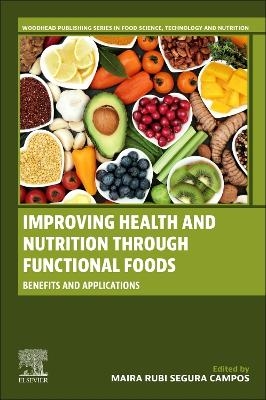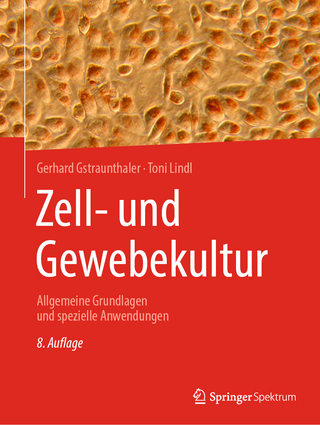
Improving Health and Nutrition through Functional Foods
Woodhead Publishing (Verlag)
978-0-443-21874-3 (ISBN)
- Noch nicht erschienen (ca. Januar 2025)
- Versandkostenfrei innerhalb Deutschlands
- Auch auf Rechnung
- Verfügbarkeit in der Filiale vor Ort prüfen
- Artikel merken
Maira Rubi Segura Campos is the lead research professor at the Faculty of Chemistry Engineering and the coordinator of the Institutional Postgraduate in Chemical and Biochemical Sciences at the Autonomous University of Yucatan, Mérida, Mexico. She has authored 115 articles in national and international journals, 61 book chapters, 12 books, and 41 memoirs. She has also taught more than 170 courses at the pre-and postgraduate level and has actively participated in 170 national and international academic events.
I. Fundamentals of Postbiotics
1. Postbiotics and Host Microbe Interactions
2. Insights into Probiotics Microorganisms
3. Postbiotics from Lactobacillus sp
4. Postbiotics from Bifidobacterium sp
5. Postbiotics from Lactococcus sp
6. Postbiotic from Saccahomyces sp
7. Postbiotics from non-LAB microbes Akkermansia
8. Postbiotics from non-LAB microbes Bacillus
9. Analysis of Postbiotic Metabolites from Probiotic Microbes
10. Analysis of Postbiotics from Fermented Dairy Food
11. Analysis of Postbiotics from non-dairy fermented food
12. Separation, Characterization, and Identification of Postbiotics from Probiotic Microbes
13. Methods Of Postbiotic Preparations and Optimization
14. Next Generation Sequence Analysis of Postbiotics in Fermented Food
15. Next Generation Probiotics as Sources of Postbiotics
16. Genomic characterization of Postbiotics
17. Nutritional Features and Safety of Postbiotics
18. Delivery and Dose Form of Postbiotics
19. Challenges and Limitations of Postbiotics
II. Postbiotics Types and Mechanisms
20. Exopolysaccharides as Postbiotics
21. Short Chain Fatty Acids as Postbiotics
22. Biosurfactants As Postbiotics
23. Enzymes And Vitamins from Probiont as Postbiotics
24. Microbial Peptides as Postbiotics
25. Bacterial Lysate and Techoic Acid as Postbiotics
26. Mechanisms of Postbiotics Action
27. Commercially Available Human and Animal Postbiotics
28. Postbiotic Effects on Drug Metabolism and Therapeutic Outcomes
29. Postbiotics Metabolisms in a Dysbiotic Human Gut
30. Meta-Analysis of Postbiotics
III. Applications of Postbiotics in Health and Pharmaceutical Industry
31. Postbiotics: A Health Promoters in Human and Animals
32. Multi-Omics to Understand the Effect of Postbiotics on Human Physiology
33. Meta-Analysis for the Use of Post Biotics for Pre-Clinical and Clinical Trials
34. Antimicrobial Effects of Postbiotics
35. Prevention of Microbial Infections by Postbiotic Metabolites
36. Prevention of Food Allergies Using Postbiotics
37. Anticancer And Antioxidant Activity of Postbiotics
38. Antioxidant Activity of Postbiotics
39. Anti-Inflammatory Effects of Postbiotics
40. Anti-Atherosclerotic Effects of Postbiotics
IV. Applications of Postbiotics in Non-Human Host
41. Postbiotic Metabolites in Livestock Feeding
42. Postbiotics Metabolites in Aquaculture
43. Growth And Immunomodulatory Postbiotic Effects in Fish
44. Growth And Immunomodulatory Postbiotic Effects in Shrimp
45. Growth And Immunomodulatory Postbiotic Effects in Poultry
46. Growth And Immunomodulatory Postbiotic Effects in Pigs
47. Growth And Immunomodulatory Postbiotic Effects in Mice
V. Applications of Postbiotics in Food Industry
48. Biopreservation of meat and fish products using Postbiotics
49. Biopreservation of Dairy Products Using Postbiotics
50. Biopreservation of Vegetables and Fruits Using Postbiotics
51. Bacteriocin: Novel Ingredients as Food Biopreservatives
52. Postbiotics Food Packing Based on Organic Acids and Peptides
53. Postbiotics Food Packing Using Bacteriocin
54. Antibiofilm Activity of Postbiotics
55. Degradation of Bisphenol a Using Postbiotics
56. Biodegradation of Pesticides Using Postbiotics
57. Biodegradation of Mycotoxins Using Postbiotics
58. New Product Developments from Postbiotics
59. Preservation of Postbiotics
| Erscheint lt. Verlag | 1.1.2025 |
|---|---|
| Sprache | englisch |
| Maße | 191 x 235 mm |
| Themenwelt | Naturwissenschaften ► Biologie ► Mikrobiologie / Immunologie |
| Technik ► Umwelttechnik / Biotechnologie | |
| ISBN-10 | 0-443-21874-9 / 0443218749 |
| ISBN-13 | 978-0-443-21874-3 / 9780443218743 |
| Zustand | Neuware |
| Haben Sie eine Frage zum Produkt? |
aus dem Bereich


